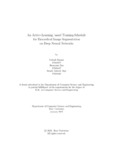An active-learning based training-schedule for biomedical image segmentation on deep neural networks
Abstract
Biomedical image classification and segmentation are quite important tasks for medical diagnosis. Many Deep Neural Networks (U-Net, V-Net, etc) have been used in
recent years to segment biomedical images. For classification of biomedical images
or 3D data (X-Ray, CT scan, MRI), ResNet, DenseNet, Xception, Inception, etc.
have been in use for automatic disease diagnosis. But all of these networks are
trained end-to-end and they do not accumulate anatomical information that is required to interpret similar data in the same way Radiologists do. A new research
direction would be to make the network aware of key anatomical locations and their
relative positions while generating predictions. We investigated the roles that Active
Learning can play in the development and deployment of Deep Learning enabled diagnostic applications and focus on techniques that will retain significant input from
a human end-user. In order to practically understand the drawbacks of existing approaches using different networks, we benchmarked the MICCAI BraTS 2019 dataset
on different Neural Networks. To overcome the drawbacks of existing approaches
of different networks we have incorporated an uncertainty-based Active Learning
Training Schedule to segment biomedical images. Through this approach, we have
achieved a much better performance than the traditional end-to-end approaches on
Deep Neural Networks for biomedical image segmentation.

